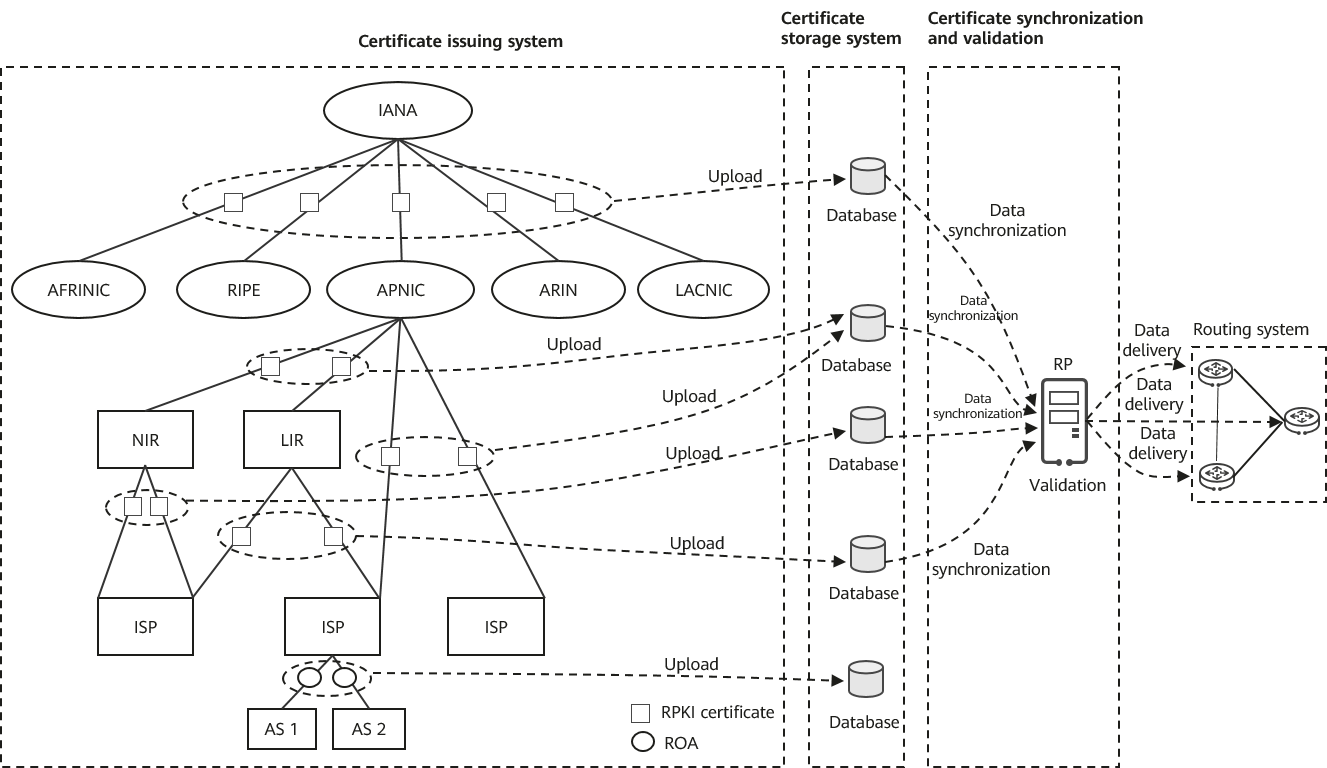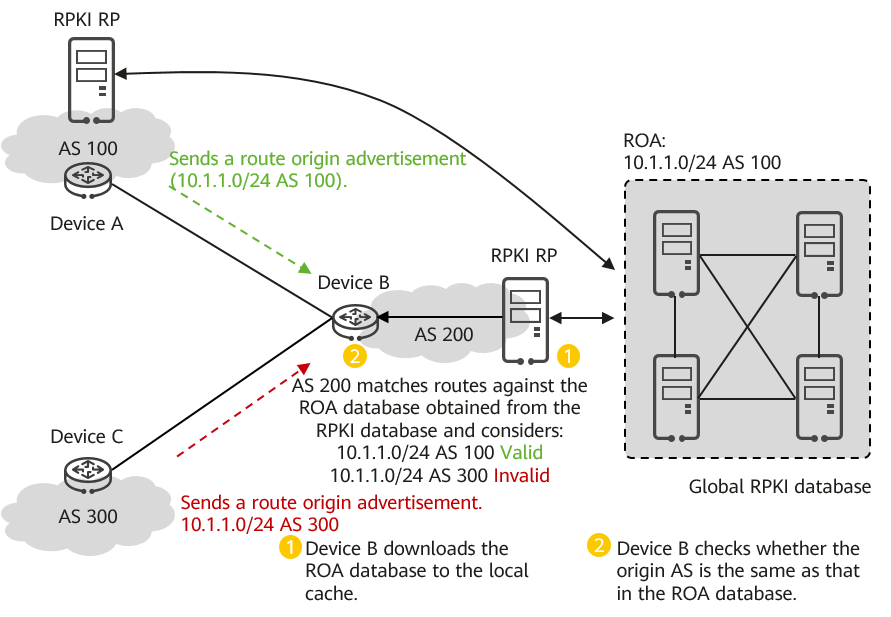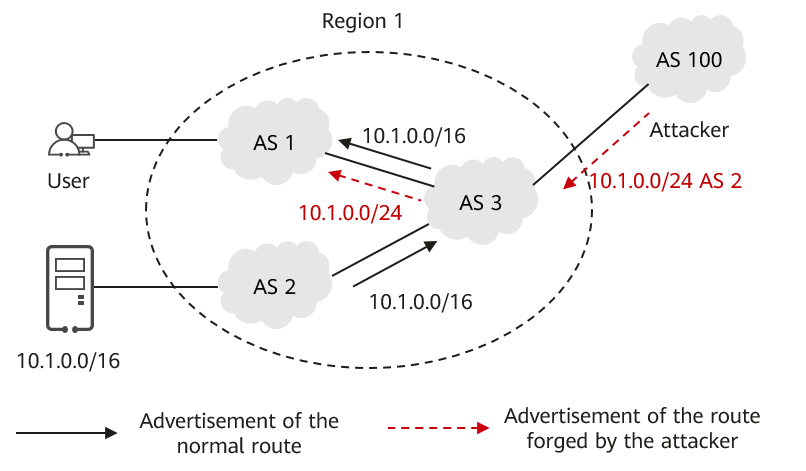What Is RPKI?
Resource Public Key Infrastructure (RPKI) is a PKI-based technology specially used to prevent network security problems such as route hijacking by verifying the authenticity and validity of BGP-advertised routing information.
PKI is a technology used to manage and validate digital certificates, primarily to ensure the security and integrity of data exchange. RPKI is an application of PKI and is used to ensure the security of BGP routes.
Why Do We Need RPKI?
The early Internet consisted of several core autonomous systems (ASs) and some edge ASs. These ASs exchanged routing information through an inter-AS routing protocol — BGP — to ensure reachability of Internet routes. At that time, the main objective was to transmit data successfully, and the ASs were mutually trusted. As such, the authenticity and reliability of routing information were not considered during BGP design. However, as the Internet evolved from a simple information sharing platform to a commercial platform, thousands of routable ASs have emerged on the global Internet. Today, with so many ASs, it is difficult to ensure that the routing information advertised by each AS is complete, authentic, and reliable. Without any security mechanism, inter-AS routing systems face severe security threats when peers advertise fake routing information.
BGP, a widely used inter-AS routing protocol, is the basic guarantee for interconnection and interworking between ASs around the world. However, because BGP cannot ensure the authenticity of route advertisements, route hijacking may occur due to network attacks or incorrect configurations. Route hijacking severely impacts how the Internet runs, and large-scale hijacking may even cause widespread network breakdown. Currently, one of the most serious security threats to BGP is BGP prefix hijacking, which can be classified into prefix hijacking and sub-prefix hijacking, as shown in Figure 1 (b) and Figure 1 (c). Figure 1 (a) shows a scenario in which BGP advertisement is normal. AS 1 is the valid holder of the IP address 10.1.0.0/16 and advertises the corresponding route with this prefix and the AS_Path of 1 through a BGP message. After receiving the route, AS 2 sends the IP packets whose destination addresses are included in the 10.1.0.0/16 address block to AS 1, adds its AS number to the front of the AS_Path, and advertises the route. In the route, the IP prefix is 10.1.0.0/16, and the AS_Path is <2 1>. The implementation in AS 3 and AS 4 is similar to that in AS 2.
To implement route hijacking, attackers usually forge the origin AS number in a BGP message. On the network shown in Figure 1 (b), after AS 1 advertises the route 10.1.0.0/16, AS 4 forges a route advertisement, claiming itself as the origin AS (10.1.0.0/16). In this case, AS 3 receives two routes destined for 10.1.0.0/16: one route whose AS_Path length is 2 (the real route), and another whose AS_Path length is 1 (the fake route). Because BGP prefers the route with the shortest AS_Path, AS 3 selects the fake route. As a result, all traffic to be sent to AS 1 is hijacked to AS 4. This is prefix hijacking.
In sub-prefix hijacking, attackers construct messages of more detailed BGP routes to implement route hijacking. On the network shown in Figure 1 (c), after AS 1 advertises the route 10.1.0.0/16, AS 4 constructs and sends an advertisement of a more detailed route (10.1.0.0/24). Because BGP prefers the route with the longest prefix, the traffic from AS 2 or AS 3 to 10.1.0.0/24 is sent to AS 4.

BGP prefix hijacking scenarios
To prevent network security incidents such as route hijacking, Internet service providers (ISPs) wanted a technology that allows one or more ASs to be authorized by the valid holder of an IP address as initial route broadcasters of the IP address, to obtain authorization information, and to implement validation. In response, the IETF Secure Inter-Domain Routing (SIDR) working group proposed and standardized the RPKI protocol. In the example shown in Figure 1 (b), after RPKI is deployed, AS 3 determines that AS 1 is a valid broadcaster of the IP address 10.1.0.0/16 and that AS 4 is a fake broadcaster. In this case, route hijacking can be avoided.
The idea of RPKI comes from the Secure Border Gateway Protocol (S-BGP) solution proposed by BBN in 1997 to solve the BGP prefix hijacking problem. S-BGP validates the binding relationship between IP address prefixes and AS numbers through AS signatures that are added to BGP advertisements. However, drawbacks such as complex key management and high calculation overhead prevent the adoption of S-BGP. RPKI inherits the idea of binding IP address prefixes and ASs through signatures in S-BGP but abandons the approach of adding signatures to BGP advertisements, thereby eliminating the need to modify BGP's implementation and reducing the cost of border routers. Instead, RPKI independently stores signatures in the RPKI database in an out-of-band manner. A dedicated server obtains the signatures and certificates from the RPKI database and validates them. Routers then obtain the validation results from the server for route selection. Its compatibility with BGP and out-of-band design have allowed RPKI to be deployed.
RPKI has the following advantages:
- Ensures network security: RPKI validates AS authorization relationships, preventing network data flows from being hijacked by network attackers through forged routes and ensuring network security.
- Improves network reliability: RPKI improves route reliability and stability and reduces route leakage, improving network reliability.
- Protects users' commercial interests: RPKI prevents sensitive user information from being stolen by network attackers through forged routes, preventing economic loss.
- Promotes the healthy development of the Internet: RPKI ensures route security, thereby promoting the healthy development of the Internet.
How Does RPKI Work?
Important Concepts
- Internet number resource assignment architecture
Internet assigned numbers authority (IANA) is an organization that manages global Internet number resources, including IP addresses, AS numbers, and domain names. Its main responsibility is to ensure the stability and security of the Internet by formulating rules and standards for allocating global Internet number resources.
Internet number resource assignment architecture - RPKI
RPKI is a digital certificate system. Its basic function is to provide cryptographically verifiable guarantees for resources such as IP addresses and AS numbers.
- Certificate
Any resource holder who has the right to reallocate resources must be able to issue certificates for reallocated resources.
RPKI certificates include those issued by a certificate authority (CA) and by an end entity (EE). CA certificates are used to guarantee IP address and AS number assignment and associate IANA with the regional Internet registries (RIRs), national Internet registry (NIR), and Internet service providers (ISPs). EE certificates are used to validate Route Origin Authorization (ROA).
An entity that holds CA certificates is called a CA. Each CA maintains its own database for relying parties (RPs) to synchronize its certificates and signature objects. The databases of all CAs constitute an RPKI database, which is a certificate storage system — an important part of the RPKI architecture.
- ROA
ROA refers to the authorization of an IP address by its owner to an AS.
- RPKI database
The RPKI database is used to store certificates and signatures.
- RPKI RP
An RPKI RP is a bridge between the RPKI system and the Internet inter-AS routing system. The RP periodically downloads certificates and ROA signatures from the RPKI database and validates them to obtain the binding relationship between IP address prefixes and AS numbers. The RP delivers the validation results to routers. Based on the results, the routers determine the authenticity of BGP routing messages.
RPKI Architecture
RPKI is a dedicated PKI framework developed by the IETF SIDR Working Group and is defined by nearly 30 RFCs. One of the RFCs defines the RPKI architecture, which includes the certificate issuing system, certificate storage system, and certificate synchronization and validation mechanism. The RPKI architecture ensures the normal running of the RPKI system.

RPKI architecture
The following components constitute the RPKI architecture:
- Certificate issuing system: It consists of RPKI certification centers located around the world and is used to issue RPKI resource certificates.
- Certificate storage system: All RPKI-related certificates are stored in the RPKI database, which has a distributed storage structure and consists of many databases.
- Certificate synchronization and validation mechanism: RPs synchronize and validate RPKI certificates and signature objects from the RPKI database. After synchronization and validation, the RPs provide the validation results (binding relationship between the IP address prefixes and AS numbers) to the border routers in the Internet inter-AS routing system which consists of BGP routers deployed in different ASs. The routers then use the validation results to filter routes.
Route Origin Validation Process
The RPKI certificate issuing system, as shown in the following figure, corresponds to the Internet number resource assignment architecture. This system issues resource certificates level by level from top to bottom to authorize resources. The certificates contain the binding relationship between IP address prefixes/AS numbers and receiving organizations, indicating that the resource holder is authorized to use the number resources.

RPKI certificate issuing system
The preceding figure is used as an example to describe the process of issuing resource certificates from top to bottom:

This example simplifies the resource certificate issuing process and the certificate format to facilitate understanding.
- Asia-Pacific Network Information Center (APNIC) issues a self-signed root certificate (1): {issuer: APNIC; receiver: APNIC; number resource: 10.1.0.0/16, 10.2.0.0/16, AS 1-AS 99}. After the certificate is generated, APNIC stores the certificate in its own database.
- APNIC uses root certificate (1) to issue resource certificate (2) to ISP1: {issuer: APNIC; receiver: ISP1; number resource: 10.1.0.0/18, 10.2.0.0/20, AS 1-AS 9}. After the resource certificate is generated, ISP1 stores it in its own database.
- ISP1 uses certificate (2) to issue ROA signature (3): {issuer: ISP1, binding relationship: 10.1.1.0/24 & AS 1}. The ROA signature specifies the binding relationship between an IP prefix and an AS number. By issuing this signature, ISP1 authorizes the AS to initiate route origin advertisements.
On the network shown in the following figure, Device B in AS 200 receives two route origin advertisements with the same prefix (10.1.1.0/24) but different AS numbers. Without RPKI, Device B cannot determine which AS is the valid origin AS. If an RPKI RP is deployed, Device B can download the ROA database from the RPKI database. Based on the ROA database, Device B determines that the binding relationship of <10.1.1.0/24 AS 100> is valid. After Device B receives two routes with the same prefix (10.1.1.0/24) but different AS numbers, one from AS 100 and the other from AS 300, Device B matches the origin AS numbers against the ROA database. The route 10.1.1.0/24 learned from AS 100 is valid because its origin AS matches the ROA database. As such, the route advertisement from the origin AS 100 is considered valid. The route 10.1.1.0/24 learned from AS 300 is invalid because its origin AS does not match the ROA database. As such, the route advertisement from the origin AS 300 is considered invalid.
If no RPKI RP is available, a static ROA database can be configured on Device B to implement ROA validation, which can also prevent route hijacking to some extent.

ROA validation
RPKI Function Extension
As an RPKI validation mechanism, regional validation controls route selection results by checking whether the routes received from EBGP peers in an external region belong to the local region. This prevents local region routes from being hijacked by attackers outside the local region, and ensures that hosts in the local region securely access internal services.
Regional validation applies to the following typical scenarios: regional validation scenario and regional confederation validation scenario.
Regional validation scenario
On the network shown in the following figure, AS 1, AS 2, and AS 3 belong to a carrier's network, and AS 3 connects to AS 100, which belongs to another carrier's network. A user accesses the server at 10.1.0.0/16 in AS 2 through AS 1. In normal cases, the user accesses the server through the path AS 1 -> AS 3 -> AS 2. If an attacker in AS 100 forges a route 10.1.0.0/24, the traffic for the user to access the server will be stolen by the attacker because the route advertised by the attacker is more specific. To solve this problem, you can configure regional validation on the border router of AS 3 and combine AS 1, AS 2, and AS 3 into region 1. With regional validation, AS 3 considers the attack route invalid or reduces its priority because although its source is AS 2, which belongs to the local region, the route is received from a BGP peer outside region 1 (in AS 100).

Regional validation scenario
Regional confederation validation scenario
On the network shown in the following figure, AS 1, AS 2, and AS 3 belong to a carrier's network, and AS 4 and AS 5 belong to a partner carrier's network. AS 3 and AS 4 are connected to AS 100, which belongs to another carrier's network. A user accesses the server at 10.1.0.0/16 in AS 5 through AS 1. In normal cases, the user accesses the server through the path AS 1 -> AS 3 -> AS 4 -> AS 5. If an attacker in AS 100 forges a route 10.1.1.0/24, the traffic for the user to access the server will be stolen by the attacker because the route advertised by the attacker is more specific. To solve this problem, you can configure regional validation on the border router of AS 3, and combine AS 1, AS 2, and AS 3 into region 1, AS 4 and AS 5 into region 2, and regions 1 and 2 into regional confederation 1. With regional validation, AS 3 considers the attack route invalid or reduces its priority because although its source is AS 5, which belongs to the local regional confederation, the route is received from a BGP peer outside the regional confederation (in AS 100).

Regional confederation validation scenario
- Author: Liu Yan
- Updated on: 2023-07-20
- Views: 2601
- Average rating:








